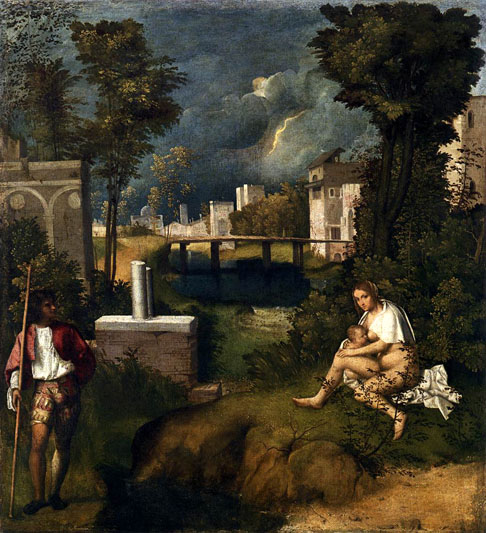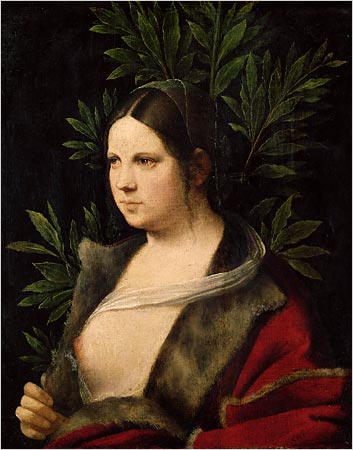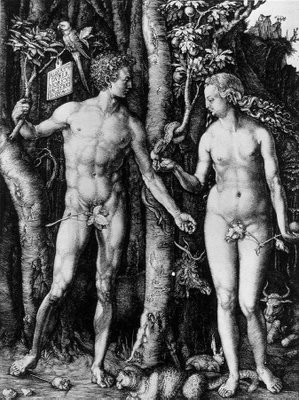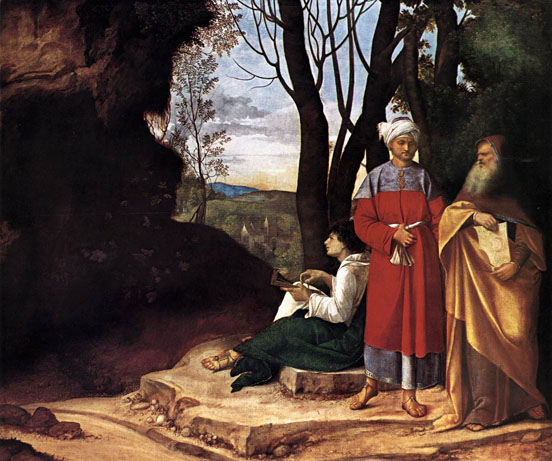The Tempest has been called the first landscape in the history of Western painting. The subject of this painting is unclear, but its artistic mastery is apparent. The Tempest portrays a soldier and a breast-feeding woman on either side of a stream, amid a city’s rubble and an incoming storm. The multitude of symbols in The Tempest offer many interpretations, but though several are compelling, none is wholly satisfying. Theories that the painting is about duality (city and country, male and female) have been dismissed since radiography has shown that in the earlier stages of the painting the soldier to the left was a seated female nude.

Hoocher:It was already in 1530 described simply as "the little landscape on canvas with a tempest, a gypsy woman and a soldier..." This painting, the meaning of which has been greatly debated, marks a moment of capital importance in the renovation of the Venetian style painting, and perhaps is the most representative of the very few genuine surviving works of Giorgione.
Thus the mystery remains of what exactly the significance is of the fascinating landscape caught at this particular atmospheric moment, the breaking of a storm. Anxious waiting seems to characterize the mood of both the human figures, absorbed in private reveries, and every other detail, from the little town half-hidden behind the luxuriant vegetation and the lazy, tortuous course of the stream to the ancient ruins, the houses, the towers and the buildings in the distance which pale against the blue of the sky.
Giorgione’s, La Tempesta (1505-1510), distinguishes itself among Italian Renaissance paintings for countless attributes. However, chief among its distinctions is the enigmatic quality of its subject resulting in scholarship rivaled by the likes of da Vinci’s Mona Lisa; interestingly enough, a painting nearly contemporaneous with The Tempest. Giorgione’s Tempest is a work of such grand wisdom, that only its shadow falls on the painted surface and therefore only a single facet of its meaning will be found by any narrow focus upon it. Further, that the true subject of The Tempest reaches far beyond the walls of a museum is evidenced by the scholarship amassed in the wake it continues to cut on humanity’s perplexed surface.

John Read:There is no evidence that Durer had an acquaintance with alchemy so intimate as, say, that of Chaucer in an earlier age; nevertheless, alchemy formed an essential ingredient of the cultural background of his times. To contemporary men of culture in general, as to the alchemist in particular, the "Melencolia" must have appeared as a rich repository of the pictorial symbolism of alchemy. The Roman numeral "I" following the engraved title suggests at once that Durer had it in mind to design and execute a series of four copper-engravings illustrating the Four Temperaments: melancholic, phlegmatic, choleric, and sanguine. These were linked in the medieval mind with the Four Elements of the alchemists and certain other mystical groups of four, a magical number inherited from the early civilizations that flourished long before the time of Pythagoras.
We find ourselves immersed in the peculiar silence, a strictly nonliterary atmosphere, that characterizes all great visual art. It is deepened by the stillness of a sultry Italian afternoon the moment before a thundershower breaks. The woman suckles her baby, if indeed it his hers, with an air of unsentimental habit and states questioningly, rather brazenly , in our direction; she seems as unaware of the man as he is of her. He gazes at her without seeing her; he may be just idly waiting for the sound, that in a second, forever in the future, will rumble down from the distant lightning.
An standard interpretation as an allegory for a Renaissance cliché about constancy, love and chance is inconsistent with what Kenneth Clark called the painting’s “magical power” . However, a painting is not a puzzle, its an experience. Thus, the existence of an allegorical meaning does not preclude the possibility of a narrative one. The Renaissance produced a multiple of pictures that can be regarded both as moralities and as stories, or at least as dramatic situations involving clearly identifiable figures and settings.
The alterations proven by X-rays, show some unknown narrative stimulating the imagination and evidence of some improvisation. The improvising produced a level of meaning that can be called philosophical or lyrical, according to the viewers temperament. On this level, Lionelli Venturi’s interpretation looks essentially correct, as it does not on the allegorical and narrative levels: here, the subject is man integrated into nature- which is to say, that it is also nature integrated into man. The same subject appears in the portrait “Laura” which seems to refer less to Petrarch’s mistress than to the Daphne who escaped Apollo’s advances by being transformed into a laurel:

The analogy with Tempesta is rendered piquant by the circumstances that "Laura" is clearly the same woman, although a little heavier, who posed for the "gypsy." Was she the "certain lady" , probably a Venetian courtesan from whom the painter caught the plague?
“The Tempest demonstrates a level of sophistication that transcends a mere pictographic treatment and demands a more thorough investigation before it is proved to be the conceptual work it really is. It is a perfect Ouroboros: the snake that eats its own tail, the renewal of life from death, the union of all that is opposed. For, to probe the meaning of The Tempest is to explore the dichotic archetypes of the human psyche through its circle of development toward individuation. A bold assertion, I realize, but that is my argument. This was not only true during the artist’s own lifetime, but is still true today as evidenced by the ongoing argument of its Hidden Subject. The Tempest is profoundly provocative and whether conscious of its implications or not, the artist is properly credited with the genius embodied in this painting.” ( Morales )

Morales:Has the knowledge required to accurately decode this work disappeared through a gradual erosion of detailed nuances that together form the key to its message. " a selection is made and what fits or coincides with what is already known is handed on, while other details tend to get dropped, because they seem strange and one does not know how to deal with them." On the other hand, by means of secret knowledge, perhaps Giorgione has cleverly articulated a message which resonates at a super or subconscious level. "We see colors, not wavelengths," writes Jung. Of course this suggests that all we can identify is not necessarily the extent of the phenomenon. Jung goes on, "The personal psychological equation becomes ever more important in the presentation and communication of observations, to say nothing of the interpretation and abstraction of the experimental material."This is where the snake's tail enters its own mouth. For, in examining the experimental material before me, I have made choices about what to consider or not thus creating a new psychological phenomenon from the material and thereby perpetuating the
hic continuum that is the real Hidden Subject of The Tempest: I see me examining myself.One might wonder why the Alchemists communicated in coded pictures rather than written codes. This is quite easily explained by another fundamental principle of Alchemy, which is, the Work they did was of such a divine nature, that it transcended the intellect and spoke on other wavelengths where words are inadequate. “Whenever we [Alchemists] have spoken openly we have actually said nothing. But where we have written in code and in pictures we have concealed the truth.” I am not arguing that Giorgione was an Alchemist. I instead inject the Alchemical principles into this discussion to illustrate the prolific dissemination of codified imagery during this period of art history. The Alchemists were not the only constituency speaking through coded images. ( Morales )

Mark E. Koltko-Rivera:Another issue that comes to mind is the idea of Adam and Eve as a married couple. In traditional belief, Adam and Eve were married by God in the Garden of Eden. (See, in the Jewish Tanakh or the Christian Bible's Old Testament, the passage Genesis 1:28.) Symbolically, however, marriage of male and female has sigificance in esoteric studies and alchemy (see C. G. Jung, Collected Works, vol. 13, "Alchemical Studies," and vol. 14, "Mysterium Coniunctionis"). Thus, Durer's Adam and Eve print and painting may touch upon alchemical themes that we have met in Clue #18 and shall meet again in Clue #25 (the Rosy Cross).
ADDENDUM:
J.Eric Morales: Senior by several centuries and concurrent with the development of Christianity, Alchemy suffered a similar ideological split twelve hundred years later and much closer to Giorgione’s day. Alchemists, or the mystical group of pre-Renaissance scientist-philosophers, eventually bifurcated into the chemists who assimilated into the natural sciences and the philosophers who eventually bore the Free Masons, Rosicrucians, Theosophists, Anthroposophists and many other related, secretive spiritual groups who, like the Gnostics, believe in the indispensable power of the intellect in the search for the Devine. Thus, the undercurrents of mysticism were prevalent among the artists of the time.
One such artist at the center of this cultish movement was Albrecht Dürer. The significance here, is that Dürer illustrated a widely disseminated treatise called Hieroglyphica by Horapollo. This fifth century Egyptian philosopher identified the symbolic key to over two hundred symbols of Egyptian hieroglyphics. This book became the basis of symbology used in the emblem paintings for decades to follow, a book that is known to have “prompted the artists of the Renaissance, including Bellini, Giorgione, Titian, and Bosch, to develop the language of signs in their own imaginative way.” It is of no small significance that the symbology Giorgione employed in his commissions, due to the influences and demands of his time, is parallel with Alchemical symbology, for the latter, having roots back to the waning days of the late Egyptian dynasties, employed many of the same motifs found in the Egyptian hieroglyphs that Dürer illustrated and his contemporaries utilized. Dürer’s contribution to this history is no small matter either, for he did not simply transcribe the hieroglyphs, but illustrated in his imaginative way, the concepts that each hieroglyph represented thereby giving birth to a whole new modern vernacular on an ancient way of communicating ideas through icons. This clarification is intended to anticipate the reader who is expecting to see an Ankh or an Osiris alongside Adam and Eve.

X rays of the Three Philosophers show that several important features were changed in the course of execution.
Arguably the most visible revival of Alchemical philosophy in recent times is found in the work of Dr. Carl G. Jung, early in the twentieth century. Jung’s work reached an impassioned level when he made a direct connection between his work in psychoanalysis and his intellectual fascination with the Alchemists. This resonance prompted his theory of the Collective Conscience which became the basis of all the work that followed. Jung theorized that the psyche is oriented toward one of two archetypes. Introversion is subject related, while Extroversion is object related. Jung’s theory asserts that the human psyche is in a constant state of tidal flux in an attempt to find the perfect balance of both object and subject relation with the ideal end found in ‘individualization’ – a state wherein the individual’s psychology is perfectly balanced between the self and the collective, or (loosely) society.





 COMMENTS
COMMENTS